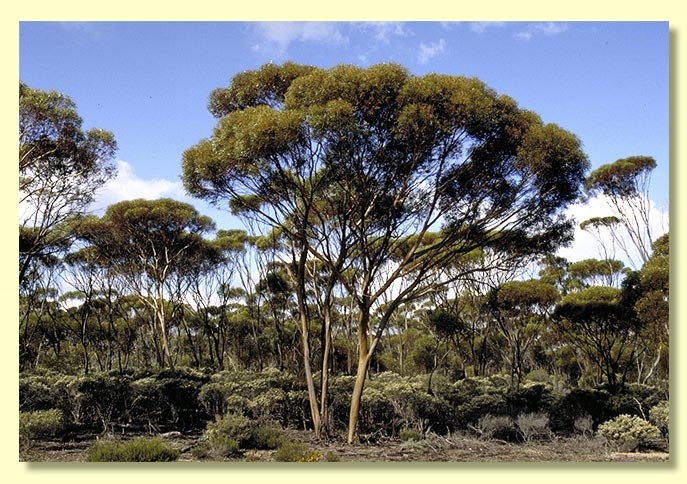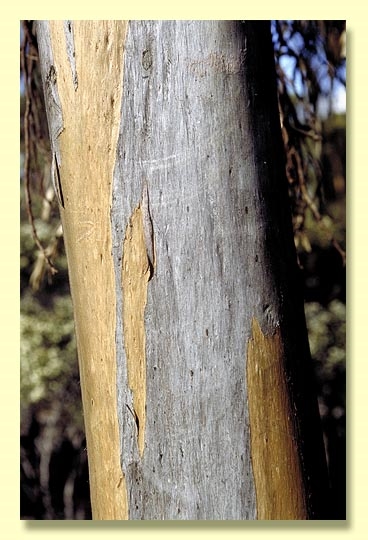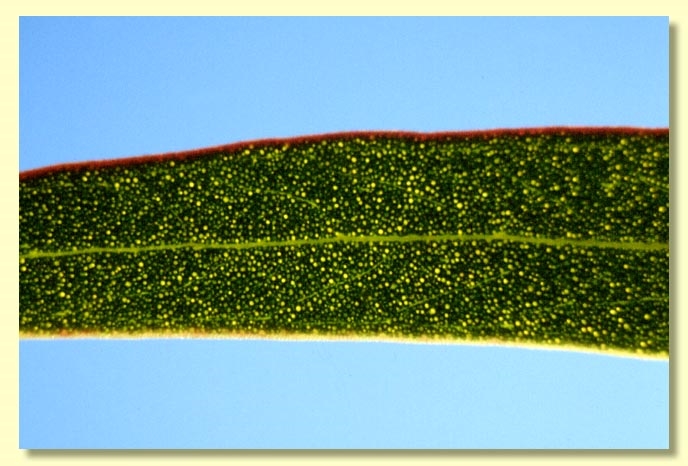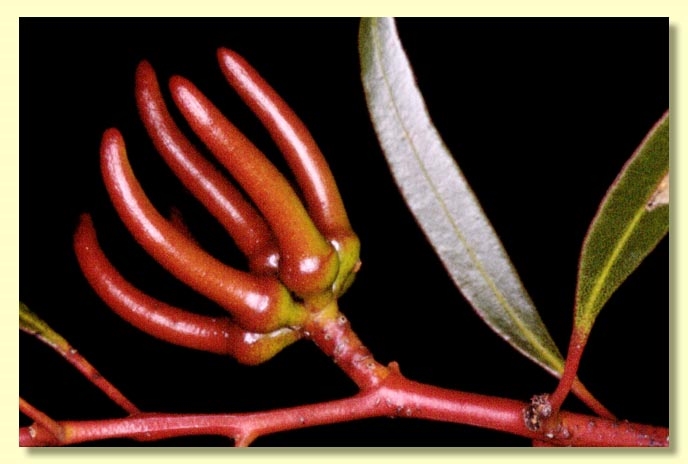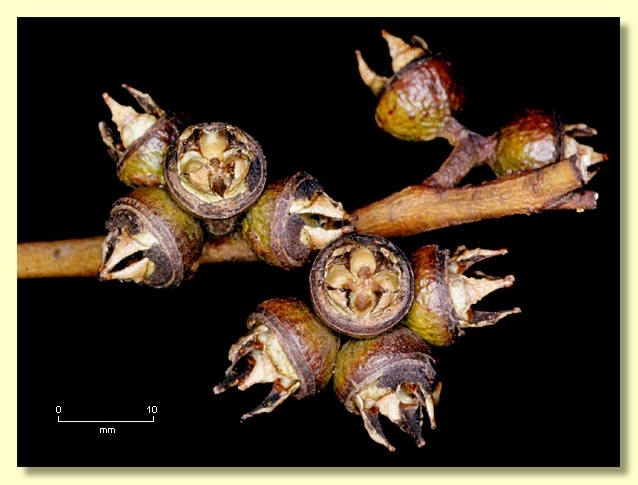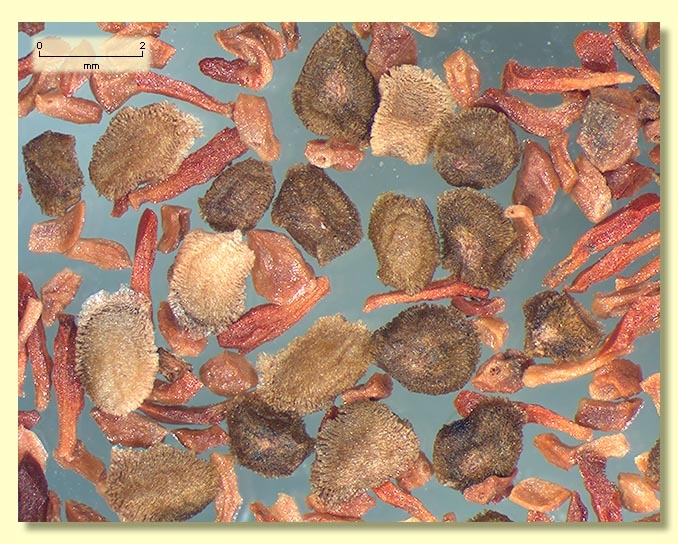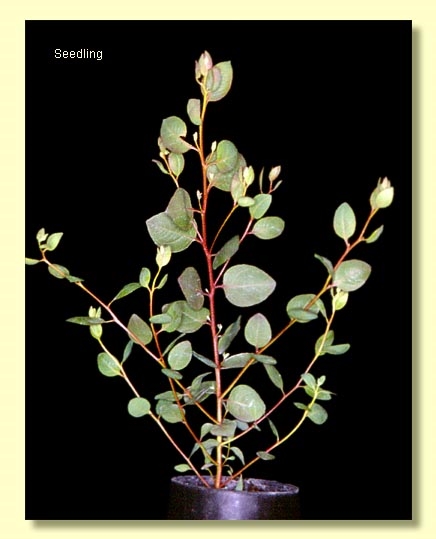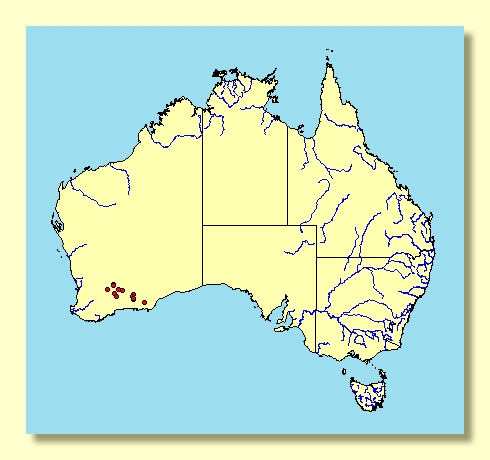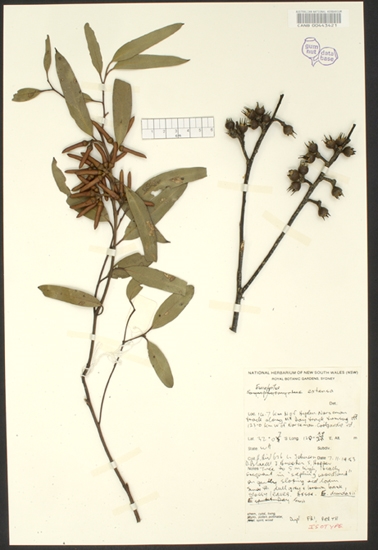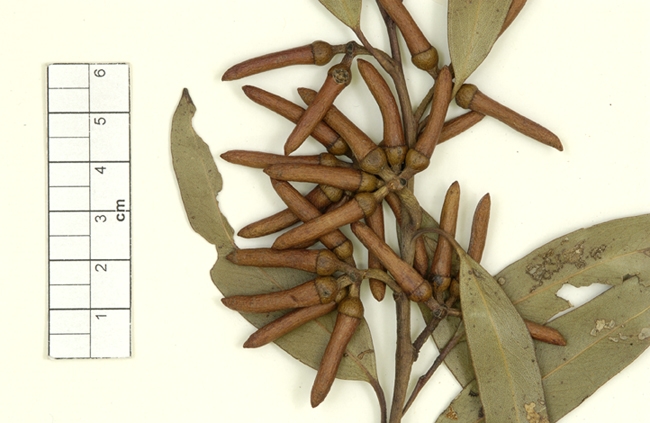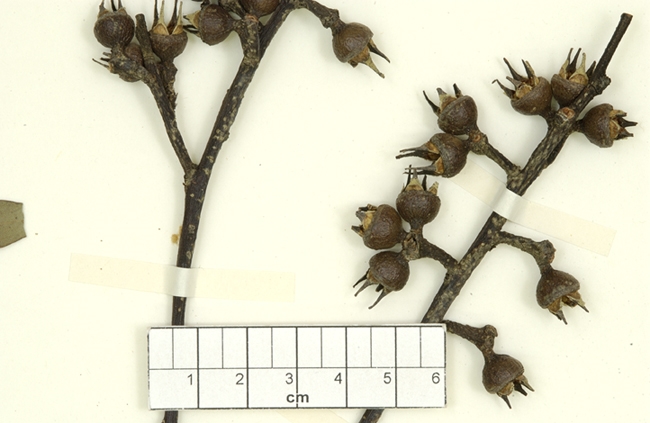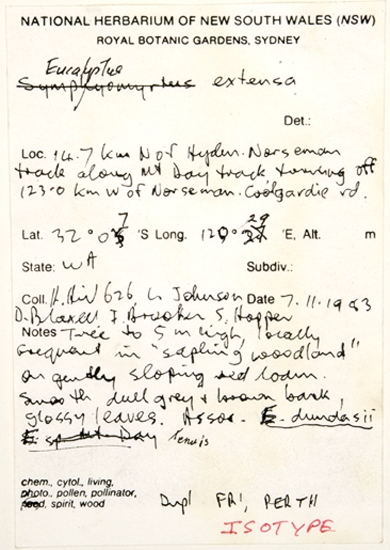Eucalyptus | Symphyomyrtus | Bisectae | Glandulosae | Erectae | Annulatae
Euclid - Online edition
Eucalyptus extensa
Classification
Nomenclature
Eucalyptus extensa L.A.S.Johnson & K.D.Hill, Telopea 4: 219 (1991).
T: Western Australia: 14.7 km N of Hyden-Norseman track along Mt Day track, turnoff 123.0 km W of Norseman-Coolgardie road (32°07'S, 12°29'E), 7 Nov. 1983, K.Hill 626, L.Johnson, D.Blaxell, I.Brooker & S.Hopper; holo: NSW; iso: CANB, K, PERTH.
T: Western Australia: 14.7 km N of Hyden-Norseman track along Mt Day track, turnoff 123.0 km W of Norseman-Coolgardie road (32°07'S, 12°29'E), 7 Nov. 1983, K.Hill 626, L.Johnson, D.Blaxell, I.Brooker & S.Hopper; holo: NSW; iso: CANB, K, PERTH.
Description
Mallet to 12 m tall. Non-lignotuberous.
Bark smooth, of 'oily' appearance, dark grey to light brownish grey over yellowish green or bronze.
Pith glands present in branchlets; three-year old branchlets sometimes become glaucous.
Juvenile growth (coppice or field seedlings to 50 cm): not seen.
Adult leaves held more or less erect, alternate, petiole 0.6–1.7 cm long; blade narrowly lanceolate, 4–10.5 cm long, (0.5)0.7–1.8(2) cm wide, base tapering to petiole, margins entire, apex pointed, concolorous, glossy, dark green, side-veins acute or obscure, reticulation obscured by numerous round oil glands, intramarginal vein close to edge or obscure.
Inflorescence axillary, single, peduncles broadly flattened, erect, 0.5–1.5 cm long, buds 7 per umbel, shortly pedicellate (pedicels 0.2–0.6 cm long. Mature buds 2.4–3.2 cm long, 0.5–0.7 cm wide) scar present (outer operculum shed early), operculum elongated, tapering to a point, to 5 times the length of the globular hypanthium and narrower than it at the join, stamens erect, anthers narrowly oblong, versatile, sub-basifixed with the filament tapering abruptly, dehiscing by longitudinal slits, style straight, just shorter than the longest stamens, stigma tapering to blunt, locules (3)4, the placentae convex, each with 4 to 6 vertical ovule rows or the rows indistinct. Flowers yellow-green.
Fruit erect, shortly pedicellate (pedicels 0.1–0.5 cm long), hemispherical, 0.6–0.8 cm long, 0.8–1.2 cm wide, disc narrow, descending obliquely to vertically, valves (3)4, strongly exserted.
Seeds brown to straw-coloured, 1.8–3 mm long, cuboid to ovoid, dorsal surface narrowly and irregularly fissured, ventrally ridged, the margin irregular, hilum terminal or ventral. (Seedcoat often referred to as being honey-combed.)
Cultivated seedlings (measured at ca node 10): cotyledons Y-shaped (bisected); stems square in cross-section, smooth; leaves always petiolate, opposite for 5 to 7 nodes then alternate, ovate, 2.5–4 cm long, 1.5–3.5 cm wide, base truncate to tapering, green to grey-green, dull.
Bark smooth, of 'oily' appearance, dark grey to light brownish grey over yellowish green or bronze.
Pith glands present in branchlets; three-year old branchlets sometimes become glaucous.
Juvenile growth (coppice or field seedlings to 50 cm): not seen.
Adult leaves held more or less erect, alternate, petiole 0.6–1.7 cm long; blade narrowly lanceolate, 4–10.5 cm long, (0.5)0.7–1.8(2) cm wide, base tapering to petiole, margins entire, apex pointed, concolorous, glossy, dark green, side-veins acute or obscure, reticulation obscured by numerous round oil glands, intramarginal vein close to edge or obscure.
Inflorescence axillary, single, peduncles broadly flattened, erect, 0.5–1.5 cm long, buds 7 per umbel, shortly pedicellate (pedicels 0.2–0.6 cm long. Mature buds 2.4–3.2 cm long, 0.5–0.7 cm wide) scar present (outer operculum shed early), operculum elongated, tapering to a point, to 5 times the length of the globular hypanthium and narrower than it at the join, stamens erect, anthers narrowly oblong, versatile, sub-basifixed with the filament tapering abruptly, dehiscing by longitudinal slits, style straight, just shorter than the longest stamens, stigma tapering to blunt, locules (3)4, the placentae convex, each with 4 to 6 vertical ovule rows or the rows indistinct. Flowers yellow-green.
Fruit erect, shortly pedicellate (pedicels 0.1–0.5 cm long), hemispherical, 0.6–0.8 cm long, 0.8–1.2 cm wide, disc narrow, descending obliquely to vertically, valves (3)4, strongly exserted.
Seeds brown to straw-coloured, 1.8–3 mm long, cuboid to ovoid, dorsal surface narrowly and irregularly fissured, ventrally ridged, the margin irregular, hilum terminal or ventral. (Seedcoat often referred to as being honey-combed.)
Cultivated seedlings (measured at ca node 10): cotyledons Y-shaped (bisected); stems square in cross-section, smooth; leaves always petiolate, opposite for 5 to 7 nodes then alternate, ovate, 2.5–4 cm long, 1.5–3.5 cm wide, base truncate to tapering, green to grey-green, dull.
Flowering Time
Flowering has been recorded in October.
Notes
Eucalyptus extensa is a smooth-barked mallet endemic to Western Australia. It occurs from Clyde Rock in the east to Salmon Gums and west and north-west towards Kulin, Hyden and Southern Cross, on sandy to gravelly sites. The buds are striking with long opercula and the flowers have long yellow-green stamens.
Eucalyptus extensa belongs in Eucalyptus subgenus Symphyomyrtus section Bisectae subsection Glandulosae because the buds have two opercula, the cotyledons are bisected and the branchlets have numerous oil glands in the pith. Within subsection Glandulosae, the 3 species E. extensa, E. protensa and E. annulata form series Erectae subseries Annulatae having smooth bark, buds with long operculum, erect stamens, adult leaves with numerous oil glands obscuring the sideveins and reticulation, and seed with fissured seedcoat.
E. extensa is most closely related to E. annulata from the southern subcoastal and southern wheatbelt areas, and to E. protensa which is found in the area from south of Norseman towards Balladonia. E. extensa and E. annulata both have broadly flattened peduncles whereas E. protensa has more slender, scarcely flattened peduncles. E. extensa has short stout pedicels whereas E. protensa has slender pedicels and the buds of the latter have more finely elongated opercula. E. annulata usually has sessile buds with shorter, blunt opercula compared with E. extensa and E. protensa. Both E. extensa and E. protensa are mallets whilst E. annulata is usually a mallee. Trees with rough bark and with buds somewhat similar to both E. extensa and E. annulata have been collected several times in the Nyabing area in recent years. The fruit are on the small side (0.7–0.8 cm diameter) for these taxa and further investigation is required.
Eucalyptus extensa is related to the gimlets (series Contortae ) by habit, bark type, seedcoat and the prominently exserted valves of the fruit but shares some bud and leaf characters with E. eremophila and related species (series Erectae subseries Abundae), viz. erect stamens and leaves with crowded round oil glands that completely obscure the venation.
Eucalyptus extensa belongs in Eucalyptus subgenus Symphyomyrtus section Bisectae subsection Glandulosae because the buds have two opercula, the cotyledons are bisected and the branchlets have numerous oil glands in the pith. Within subsection Glandulosae, the 3 species E. extensa, E. protensa and E. annulata form series Erectae subseries Annulatae having smooth bark, buds with long operculum, erect stamens, adult leaves with numerous oil glands obscuring the sideveins and reticulation, and seed with fissured seedcoat.
E. extensa is most closely related to E. annulata from the southern subcoastal and southern wheatbelt areas, and to E. protensa which is found in the area from south of Norseman towards Balladonia. E. extensa and E. annulata both have broadly flattened peduncles whereas E. protensa has more slender, scarcely flattened peduncles. E. extensa has short stout pedicels whereas E. protensa has slender pedicels and the buds of the latter have more finely elongated opercula. E. annulata usually has sessile buds with shorter, blunt opercula compared with E. extensa and E. protensa. Both E. extensa and E. protensa are mallets whilst E. annulata is usually a mallee. Trees with rough bark and with buds somewhat similar to both E. extensa and E. annulata have been collected several times in the Nyabing area in recent years. The fruit are on the small side (0.7–0.8 cm diameter) for these taxa and further investigation is required.
Eucalyptus extensa is related to the gimlets (series Contortae ) by habit, bark type, seedcoat and the prominently exserted valves of the fruit but shares some bud and leaf characters with E. eremophila and related species (series Erectae subseries Abundae), viz. erect stamens and leaves with crowded round oil glands that completely obscure the venation.
Origin of Name
Eucalyptus extensa: Latin extensus, stretched out, extended, referring to the long opercula.
Copyright © CANBR 2020, all rights reserved.

Web edition hosted at https://apps.lucidcentral.org/euclid
